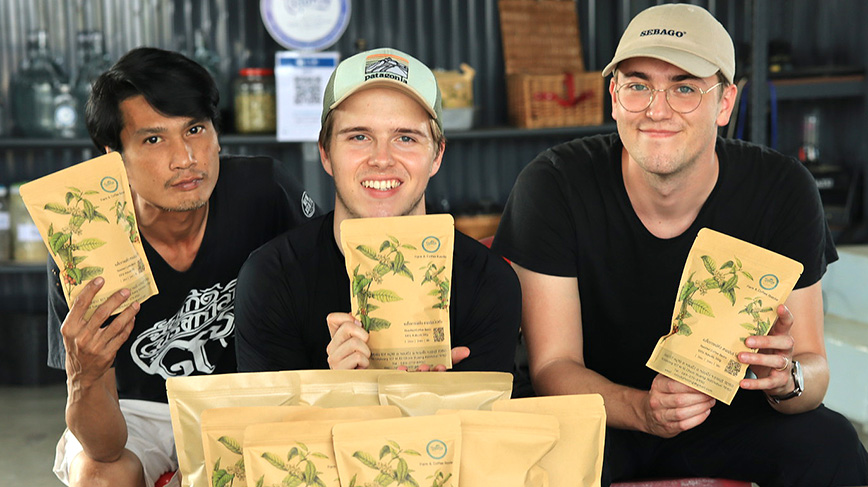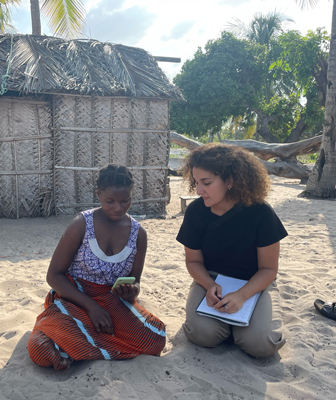Nedan finns några projektförslag från Engineers Without Borders (EWB), Stockhom Enviroment Institute (SEI) och Project Vita. Skicka ett mejl till fs-info@kth.se om du är intresserad av något av projekten, så kopplar vi ihop dig med organisationen i fråga.
Engineers without Borders (EWB)
About Engineers without Borders (EWB): Engineers without Borders in Sweden is an NGO focused on engineering solutions and sustainable technology at the heart of the green transition. EWB is a partner of Build up Nepal, collaborating to research innovative ways to replace part of the cement content in CCB with rice husk ash and other waste materials and alternative stabilizers. EWB coordinates volunteers from both industry and academia. EWB has been working on research into CSEB technology alongside Build up Nepal for the last 5 years.
Build up Nepal was established following the 2015 earthquake in Kathmandu, and has brought proven
resilient CCB technology to Nepal. Build up Nepal has supported more than 300 Micro-, Small,
Medium-sized Enterprises, MSMEs, to produce Compressed Concrete Blocks (CCBs), for over 10,000
houses in Nepal.
What EWB offers: During your thesis writing with EWB-SWE you will get concrete experience in how
international development projects are run. We have experts within different competence areas who will
support you throughout the process. EWB-SWE does not offer any additional funds.
Requirement: We want everyone who does their bachelor's or master's thesis with us to commit to providing EWB-SWE with a project report in addition to the academic report that you provide the university. We also expect the students to be active as volunteers before and after their field visit to ensure that they are well-integrated with other volunteers and our systems. From experience, we know that this is most efficient.
Further development of building materials (pdf 649 kB)
A Shock Table Earthquake Simulation Study (docx 1,3 MB)
Comparative Structural Optimization of Interlocking Bricks (docx 4,0 MB)
Investigating and Mitigating Shrinkage Crack Formation (docx 3,4 MB)
Optimising Brick Mix (docx 3,4 MB)
Partial Replacement of Cement with Additives (docx 3,4 MB)
Stockholm Environment Institute (SEI) — bridging science, policy and practice
We are an international non-profit research and policy organization that tackles environment and development challenges. We connect science and decision-making to develop solutions for a sustainable future for all. Our work spans climate, water, air and land-use issues, governance, the economy, gender and health. Stakeholder engagement is at the heart of our efforts to build capacity, strengthen institutions and equip partners for long-term change. Our knowledge and findings are accessible to decision-makers and civil society: as our own open access material, in leading academic journals, and repackaged for effective decision support. SEI has seven centers around the world – UK, the US, Thailand, Kenya, Estonia and Colombia. Our headquarters is in Sweden.
About the SEI internships
We aim to attract the most competent and skilled students and support their development by offering a professional environment with competent supervision. Recruitments are competitive and based on respect for the individual regardless of gender, gender identity or expression, age, union representation or political opinion, functional variation, sexual orientation, religion, ethnicity, nationality and marital or parental status.
General information on internships
Internship opportunities are directed to students at the master's level. While internships are generally open to all students, priority is given to matriculated university students for whom an internship is either part of their curriculum or a thesis project. Priority is also given to students from universities with whom SEI has collaboration agreements, such as KTH Royal Institute of Technology, Stockholm University, and Lund University. We welcome applications from those that have specific interests that are of relevance to the work of SEI. In general, we expect candidates to have some prior knowledge of the research area in which they will be working. The internship is linked to the writing of a master’s thesis. All interns will have an SEI supervisor assigned and are welcome to be part of our research teams and knowledge sharing activities.
Internship period
We offer two internship periods per year in alignment with the Swedish academic year: January–June and August–January. The application period for an SEI internship during the spring semester takes place in October-November (and in April for the autumn semester).
Internship opportunities at SEI Latin America
Opportunity #1
‘Innovating the tourism industry in Colombia with digital technology and knowledge.’
Context:
The Colombian government, through the Ministry of Commerce, Industry and Tourism has identified low capacities among the different actors in the value chain and the national tourism authorities for business management, adopting new technologies, and developing a sustainable, differentiated, and competitive tourism sector. To solve this problem, the project aims to implement a comprehensive strategy for innovation and digital transformation in Colombia that contributes to strengthening business management capacities and adopting new technologies by the actors in the tourism sector's value chain at the national and sub-national levels.
As part of the project´s implementation, SEI LAC will:
• Design and implement a living lab on sustainable tourism in Puerto Nariño – Amazonas.
• Design and implement a national incubation and acceleration program on innovation and entrepreneurship on tourism, following a bootcamp methodology.
Objective:
The intern will support SEI Latin America in identifying international cases and best practices around sustainable, low-carbon tourism and digital technologies for tour operators, and Indigenous communities, among others. This information should be an input for the training modules on the bootcamp or living lab, for micro, small and medium enterprises and rural communities that are part of the tourism value chain in Colombia.
Opportunity #2
Wetland Hydrogeodesy - Measuring wetland water levels from space with geodetic observations
Supervisor: Sebastián Palomino. Research Associate II, SEI-LA
Project Summary
Wetlands store roughly 10% of global surface water in the terrestrial portion of the water cycle, cover roughly 9% of the Earth’s surface, and provide critical habitat for a wide variety of plant and animal species. Over the past century, many wetland areas have been lost, degraded, or stressed mainly due to human activities, such as water diversion, agricultural development, and urbanization, but also in response to natural processes, such as sea level rise and climate change. Global and regional monitoring of wetland health and responses to natural and anthropogenic stressors is essential and best conducted using satellite data due to wetlands’ vast extent and often inaccessibility. The project explores and tests data from multiple types of satellites to measure water levels in wetlands. The measurements generate detailed multi-temporal maps of wetland inundation extent, water levels, and water level changes that provide crucial information for multiple users, including water managers and decision-makers, wetland hydrologists, and wetland ecologists.
Opportunity #3
Integrating Multiple Scales: Connecting Rural-Urban Landscapes in the Mantiqueira Mountains, Southeast Brazil
Supervisor: Cláudia Coleoni, Research Associate II, SEI Latin America
Case study location: São Francisco Xavier District, Municipality of São José dos Campos, Brazil
Landscape: Mantiqueira Mountains, Atlantic Forest Biome
Project Overview:
This project explores how to integrate rural and urban landscapes to enhance ecosystem service provision across multiple scales, particularly within the São Francisco Xavier District. Situated in the Mantiqueira Mountains, this area is vital for water regulation and biodiversity within the Atlantic Forest Biome, one of the world’s most important and threatened ecosystems.
The project emphasizes the critical role of ecosystem restoration in headwaters and its far-reaching benefits across entire watersheds, particularly for downstream urban areas and the interconnected Cantareira System, which supplies water to São Paulo. The goal is to bridge local conservation efforts with broader regional planning frameworks by creating strategies that promote collaboration between rural ecosystem service providers (such as landowners) and urban beneficiaries, including cities dependent on these vital water resources.
Project Vita
Om Project Vita: Project Vita är en ideell förening med rötterna i Sverige och Moçambique. Vårt fokuset är att förbättra levnadsstandarden för människor i Moçambique. Vi tror på att stärka och stötta de lokala samhällena så att dem har verktygen till att själva förbättra deras levnadsstandard och samhälle.
Genom att föra samman olika kulturer och samhällen med varandra ökar Project Vita välståndet i olika områden i Moçambique. Vi uppmuntrar till inblandning och engagemang på gräsrotsnivå och fokuserar på att skapa en plattform att dela och utveckla kunskap så väl som att lära sig om och förstå varandras kulturer. På så vis bygger vi en grund för förändring på lång sikt.
Projekt: Hållbara vägar på landsbygden
Område: Väg och vatten
Beskrivning: På landsbygden i Moçambique, samt övriga länder i Östafrika så är det en utmaning att underhålla vägar på landsbygden för trafik. Underlaget består ofta av sand och lera, vilket gör att vägarna är särskilt svårt utsatta under regnperioderna. Detta gör det svårt för samhällen på landsbygden att få tillgång till samhällsviktiga funktioner som är lokaliserade på mer centrala platser. Organisationen Project Vita har ett samarbete med en kommun i provinsen Inhambane, sydöstra Moçambique. Varje år får kommunen tillgång till finansiellt stöd för att reparera vägarna, men dessa reparationer förstörs ofta snabbt av regn och fordonstrafik. Kommunen önskar få hjälp i hur man kan bygga mer hållbara vägar. Studenters arbete hade alltså att i samarbete med kommun och Project Vita att på plats studera nuvarande situation och utveckla ett förslag till hållbara vägar utifrån de material som finns på plats i landet. Studenters arbete skulle sedan användas för att effektivisera kommunens underhåll av vägarna.
Projekt: Solenergidriven kylbox för förvaring av fisk på landsbygden
Område: Termodynamik / energi / mekanik / produktdesign
Beskrivning: Moçambique är ett land som sträcker sig med en lång kustremsa mot havet. Till följd av detta så är dess byar starkt beroende av fiske för tillgång till mat och för försäljning. Utmaningen är att det varma klimatet gör att fisken snabbt blir dålig eftersom dessa byar ofta saknar tillgång till möjligheter att via elektricitet kyla fisken. Dessutom är det långa transportsträckor, så fisken får oftast säljas billigare än vad den annars kunde ha sålts för. En studentgrupp har tidigare varit på plats i samarbete med Project Vita och genomfört en förstudie där man genom behovsanalys tagit fram förutsättningarna för att utveckla en portabel kylbox, driven av solenergi. Studien visade på att intresset för att köpa en sådan produkt är stor, så länge man kan dela upp enligt avbetalning eftersom dessa personer lever i fattigdom. Nästa steg i projektet är att utveckla en prototyp på produkten. Förslaget är att en eller två studentgrupper tittar på områden som; design och isolering av kylboxen, samt de tekniska funktionerna.
Projekt: Produktutveckling av solcellsdrivna produkter för landsbygden
Land: Moçambique
Område: Energi / mekanik / produktdesign
Beskrivning: Intresset för solcellslösningar är stort i Moçambique, men utmaningen är att tillgodose produkter som passar målgrupper som lever i fattigdom. Kostnaden behöver vara låg, och användning samt underhåll av produkten enkel. Dessutom behöver man se över vilka behov av solcellsdrivna produkter finns på landsbygden hos samhällsviktiga funktioner och i hemmen. Project Vita har i samarbete med provinsen varit med och tillgodosett sådana produkter både kommunalt och till familjer. Dessutom har de handlett tidigare studenter som installerat solpaneler på plats. Kommande studenters projekt hade varit att göra en behovsanalys för att se över solcellsdrivna produkter som saknas, och eventuellt utveckla förslag på en sådan produkt.


